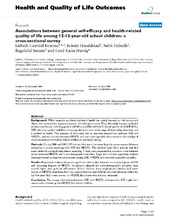| dc.contributor.author | Kvarme, Lisbeth Gravdal | en_US |
| dc.contributor.author | Haraldstad, Kristin | en_US |
| dc.contributor.author | Helseth, Sølvi | en_US |
| dc.contributor.author | Sørum, Ragnhild | en_US |
| dc.contributor.author | Natvig, Gerd Karin | en_US |
| dc.date.accessioned | 2011-02-21T15:07:10Z | |
| dc.date.available | 2011-02-21T15:07:10Z | |
| dc.date.issued | 2009-09-23 | eng |
| dc.Published | Health and Quality of Life Outcomes 7(85) | en_US |
| dc.identifier.issn | 1477-7525 | |
| dc.identifier.uri | https://hdl.handle.net/1956/4522 | |
| dc.description.abstract | Background: While research on school children's health has mainly focused on risk factors and illness, few studies have examined aspects of health promotion. Thus, this study focuses on health promotional factors including general self-efficacy (GSE) and health-related quality of life (HRQOL). GSE refers to a global confidence in coping ability across a wide range of demanding situations, and is related to health. The purpose of this study was to examine associations between GSE and HRQOL, and associations between HRQOL and socio-demographic characteristics. Knowledge of these associations in healthy school children is currently lacking. Methods: During 2006 and 2007, 279 school children in the seventh grade across eastern Norway completed a survey assessing their GSE and HRQOL. The children were from schools that had been randomly selected using cluster sampling. T-tests were computed to compare mean subscale values between HRQOL and socio-demographic variables. Single and multiple regression analyses were performed to explore associations among GSE, HRQOL and socio-demographic variables. Results: Regression analyses showed a significant relationship between increasing degrees of GSE and increasing degrees of HRQOL. In analyses adjusted for socio-demographic variables, boys scored higher than girls on self-esteem. School children from single-parent families had lower scores on HRQOL than those from two-parent families, and children who had relocated within the last five years had lower scores on HRQOL than those who had not relocated. Conclusion: The strong relationship between GSE and HRQOL indicates that GSE might be a resource for increasing the HRQOL for school children. | en_US |
| dc.language.iso | eng | eng |
| dc.publisher | BioMed Central | eng |
| dc.rights | Attribution CC BY | eng |
| dc.rights.uri | http://creativecommons.org/licenses/by/2.0 | eng |
| dc.title | Associations between general self-efficacy and health-related quality of life among 12-13-year-old school children: a cross-sectional survey | en_US |
| dc.type | Peer reviewed | |
| dc.type | Journal article | |
| dc.description.version | publishedVersion | en_US |
| dc.rights.holder | Kvarme et al; licensee BioMed Central | |
| dc.rights.holder | Copyright 2009 Kvarme et al; licensee BioMed Central | |
| dc.identifier.doi | https://doi.org/10.1186/1477-7525-7-85 | |
| dc.identifier.cristin | 345469 | |
| dc.subject.nsi | VDP::Medical disciplines: 700::Health sciences: 800::Community medicine, Social medicine: 801 | eng |

